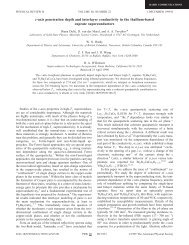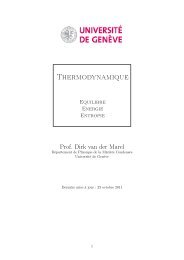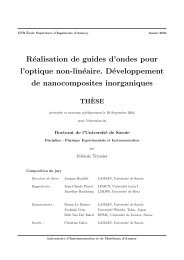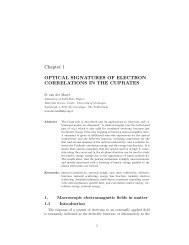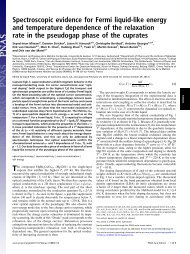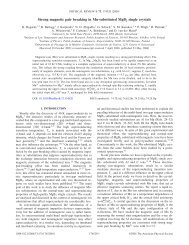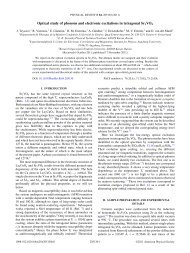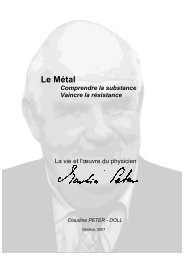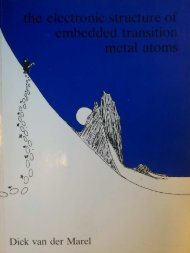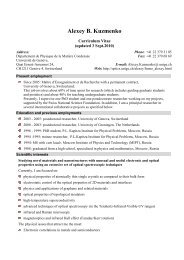software to fit optical spectra - Quantum Materials Group
software to fit optical spectra - Quantum Materials Group
software to fit optical spectra - Quantum Materials Group
You also want an ePaper? Increase the reach of your titles
YUMPU automatically turns print PDFs into web optimized ePapers that Google loves.
The list of the built-in special dielectric function formulas is given in Table 4-3. The<br />
selection might look strange at a first glance. The point is that it is not meant <strong>to</strong> be a<br />
comprehensive collection of functions for <strong>fit</strong>ting. It is rather a set of some special formulas that<br />
RefFIT users, including myself, have ever employed in their data analysis. As was mentioned<br />
in the Introduction, the list is being continuously extended and everyone can ask me <strong>to</strong> include<br />
an extra function that he (or she) would like <strong>to</strong> have. The light frequency ω is assumed <strong>to</strong> be in<br />
cm -1 . Note, that all the formulas give a dielectric function that satisfies Kramers-Kronig<br />
relations (see section 2.2.1), unless the opposite is explicitly mentioned.<br />
Dielectric function<br />
Van der Marel’s formula for the dielectric function of a non-<br />
Fermi liquid (Ref.[11], formula (15))<br />
2<br />
ω p<br />
ε = −<br />
2α<br />
1−2α<br />
ω(<br />
ω + iγ<br />
1)<br />
( ω + iγ<br />
2 )<br />
Formula for the c-axis dielectric function of cuprates with the<br />
body-centered tetragonal structure liquids (Ref.[11], formula<br />
(14))<br />
2<br />
4 2<br />
3 2 3 / 2<br />
ε = ( 60i<br />
/ ω)<br />
2σ<br />
( 1+<br />
2Ω<br />
)( 1−<br />
8Ω<br />
− 8Ω<br />
) + 16Ω<br />
( 1+<br />
Ω ) ,<br />
0<br />
where Ω = ( γ 1 − iω)<br />
/ γ 2<br />
[ ]<br />
Formula for the ab-plane dielectric function of cuprates<br />
(Ref.[11], formula (3))<br />
γ 1<br />
ε = ( 60i<br />
/ ω)<br />
σ 0<br />
,<br />
γ − iω<br />
γ + γ − iω<br />
1<br />
1<br />
The dielectric function of a weak-coupling s-wave BCS<br />
superconduc<strong>to</strong>r with arbitrary scattering rate (Ref. [12]).<br />
Parameter t is the reduced temperature t = T / Tc<br />
. The formulas<br />
of Ref.[12] are taken as they are, with τ = 1/<br />
γ , except for the<br />
temperature dependence of the gap, which in this case is<br />
π<br />
∆ ( t)<br />
= ∆ 0 cos t .<br />
2<br />
Note: the computational code is taken from Ref..[12].<br />
Drude (not Lorentz!) term with arbitrary sign of the <strong>spectra</strong>l<br />
weight<br />
A<br />
ε = −<br />
ω(<br />
ω + iγ<br />
)<br />
Note: although a negative A would have a little physical<br />
meaning for the usual dielectric function, it can be used for the<br />
differential dielectric function (see section 4.7.1).<br />
Constant (frequency independent) dielectric function<br />
ε = ε1<br />
+ iε<br />
2<br />
Note: this function is simple but obviously NOT Kramers-<br />
2<br />
Wo<br />
(code)<br />
Wp G<br />
-1 ω p<br />
[cm -1 ]<br />
α<br />
-2 γ 1<br />
[cm -1 ]<br />
γ 2<br />
[cm -1 ]<br />
-3 σ 0<br />
[Ω -1 cm -1 ]<br />
-<br />
-4 γ 1<br />
[cm -1 ]<br />
γ 2<br />
[cm -1 ]<br />
-5 σ 0<br />
[Ω -1 cm -1 ]<br />
γ 1<br />
[cm -1 ]<br />
Guide <strong>to</strong> RefFIT Page 60<br />
-6<br />
-7 ω p<br />
[cm -1 ]<br />
-8 t 0<br />
-9 A<br />
[cm -2 ]<br />
-10<br />
-<br />
ε 1 ε<br />
2<br />
γ 2<br />
[cm -1 ]<br />
γ<br />
[cm -1 ]<br />
∆<br />
[cm -1 ]<br />
γ<br />
[cm -1 ]



